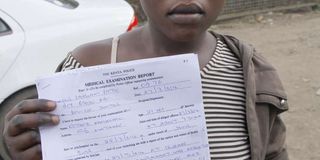Experts reviewing sexist error in P3 form

What you need to know:
- Kenya Police Medical Examination Report Form set to be revised to address existing gender discrimination gaps.
- Section 'D' only focuses on a male suspect, creating a perception that only the male gender is capable of committing a sexual offence.
- Forensic experts say this is one of the key areas on the document they are looking to change.
- Changes on document will also factor in other areas to help in forensic documentation by medics.
The Kenya Police Medical Examination Report Form popularly known as P3 is set to be revised to address existing gender discrimination gaps.
Forensic experts are currently redesigning the document, which profiles the male gender as the only one capable of committing sexual offences.
The document, which helps police document cases of assault and sexual offences, has been in used for years despite the glaring sexist error.
The P3 form, meant to be filled by a medic, contains sections that guide health professions on areas to examine in the build up for a case. A notable section of the document is the last section, which details injuries consistent with sexual assault.
On the first part, Section 'C' tackling alleged sexual offences, a medical officer is to outline findings on examination of a female and male victim alike.
However, Section 'D' only focuses on a male suspect, creating a perception that only the male gender is capable of committing a sexual offence.
Forensic experts say this is one of the key areas on the document they are looking to change, noting that women and girls can also be sexual offenders.
“The document discriminates against the male gender and that is something we are fixing and changing. It has been agreed across the justice system it needs to be reviewed,” Forensic Police Surgeon Dr Kizzie Shako told the Nation.
DOCUMENT SIZE
Dr Shako is among the team of experts spearheading the review and notes that the changes will also factor in other areas to help in forensic documentation by medics.
The review also includes increasing the size of the document.
“The spaces left for medics to indicate their findings is too small as it is, and we need to increase that to enable them to efficiently note down their observations. We are also looking to include pointers for the medic on the areas to examine and what to look for,” she said.
According to Dr Shako, the review process is in advanced stages but has been greatly hampered by the shutdown of most activities occasioned by the Covid-19 pandemic.




